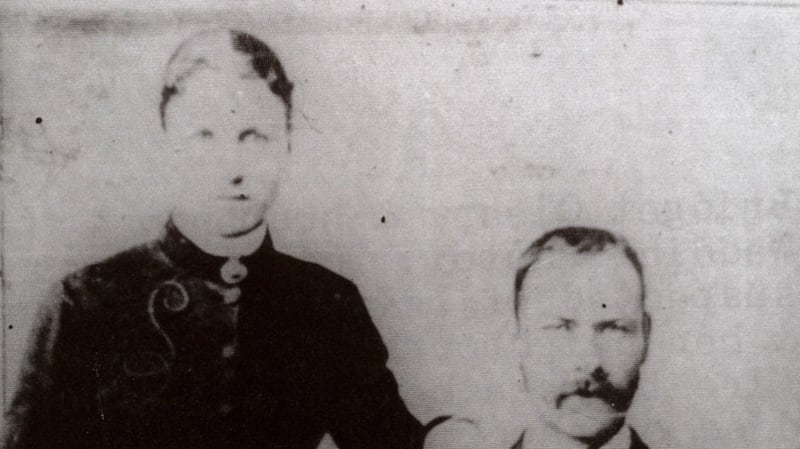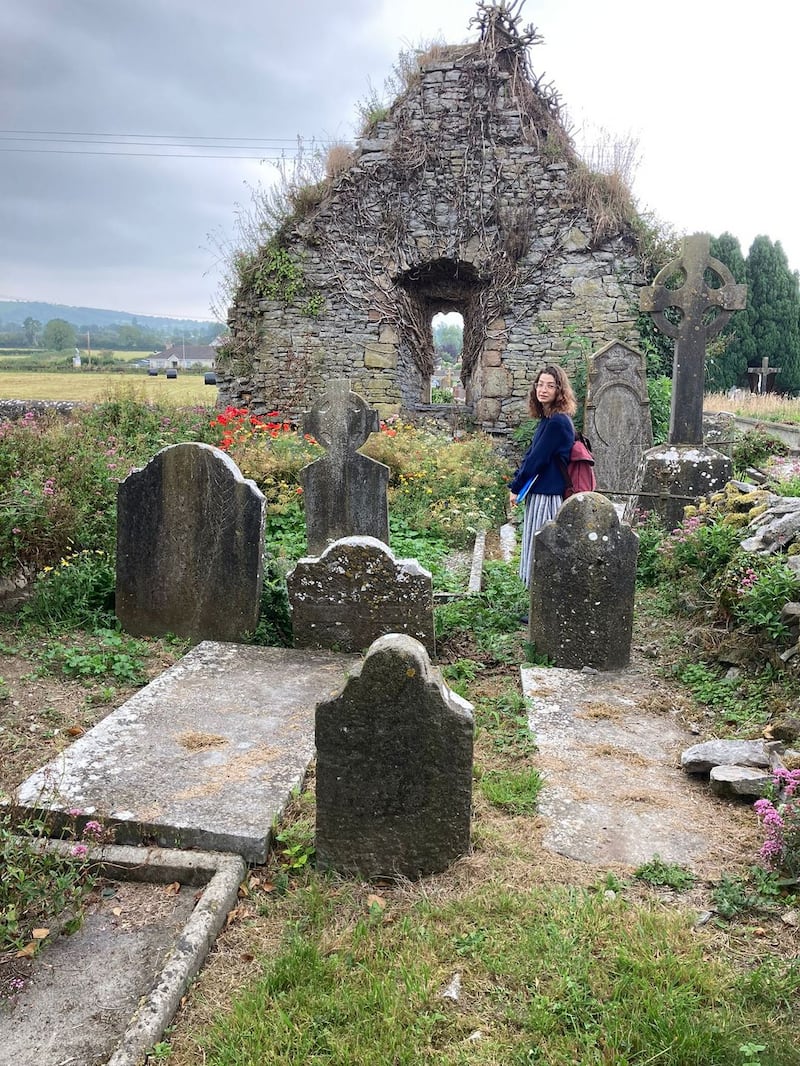I first encountered Bridget Cleary when I was 23 and she was 26, the oldest she would ever be. She was born in Ballyvadlea, Co Tipperary, in about 1869, and was murdered late in the night on March 15th, 1895. I was born less than a hundred years after her death; her story felt both close and far away.
I met Bridget in a poem. In Manteo, Medbh McGuckian footnotes Angela Bourke’s The Burning of Bridget Cleary as a source. McGuckian writes, “Word-for-word I count/ the days marooned by illness/ as in a chapel-village/ over two unbridged rivers.” The speaker is – or resembles – Bridget, who was ill in bed for 11 days before her death. The chapel-village refers to Cloneen, which my partner and I visited last September, thanks to the support of the Ireland Chair of Poetry Trust. In our hybrid rental car, we were outfitted for the future as we drove into the past.
Cloneen, Co Tipperary, is a rural village, its quiet main road bookended by a GAA club and a church. There is no memorial to celebrate or teach us about Bridget’s life and death. Even her grave in the cemetery of the Church of the Visitation is unmarked. One has to know about Bridget in order to understand what Wallace Stevens calls the “nothing that is not there and the nothing that is”. With the passage of time, her story could be lost to history.

The trip to Cloneen was the culmination of three years of research on, and writing about, Bridget Cleary. In addition to my reading, I watched documentaries, studied historical maps, visited the National Archives, enrolled in a course about the history of witchcraft, and more. At the same time, I was writing poems in the voice of Bridget and in the voices of those who killed her. I was also approaching Bridget’s age when she died.
Bridget was burned to death by her family due to their belief that she was a fairy changeling or a witch. They believed the real Bridget had been abducted and replaced by a fairy. According to Angela Bourke, Bridget is sometimes known as “the last witch burned in Ireland”. This is one way to tell her story. Here’s another: Bridget had been married to her husband for seven years, yet they were childless. And another: Bridget earned her own money by dressmaking and keeping hens. And yet another: according to the Cork Examiner, people who knew Bridget said she was “a bit queer” and “not that of every woman in the same social plane”.
In all of these narratives, Bridget was perceived as Other and therefore, a threat to patriarchal society. She was childless, financially independent, and seemingly unusual. At the end of her life, she was also ill, possibly with pneumonia or tuberculosis. The cumulative effect of these so-called societal transgressions led to Bridget’s murder.
There are so many ways of telling Bridget Cleary’s story, and all of them are imperfect. We can construct conflicting narratives from the testimonies of Bridget’s family members, who were put on trial and eventually convicted of her murder. However, the missing voice at the centre is Bridget’s. Bridget was literate, but no surviving written word of hers exists.
Bridget’s story intersects with that of William Butler Yeats, one of the most influential Irish writers of all time. In Roy Foster’s WB Yeats: A Life, Yeats and Mary Battle, his uncle’s housekeeper, discuss Bridget’s murder, also known as “the Tipperary atrocity”. Battle dismisses the accusation made by some newspapers that linked Bridget’s death to Yeats’s extensive work in Irish folklore. According to Battle, “normal practice would simply have been to threaten the fairies out”. In Yeats’s Fairy and Folk Tales of the Irish Peasantry, he writes, “Many things can be done to find out in a child a changeling, but there is one infallible thing – lay it on the fire”. Yeats suggests the possibility of other folk remedies, but ultimately defers to the “infallible” method of fire.
In the days leading up to Bridget’s murder, her family tried a myriad of cures. They consulted a doctor, a priest, a ploughman, and a so-called fairy-doctor. Bridget was given herbs and new milk and doused with urine. When her identity was questioned, she affirmed that she was Bridget Cleary.
In the cemetery of the Church of the Visitation, I stood beside Bridget’s unmarked grave. She is buried beside a wall, the border between sacred and unholy ground. A few young men and policemen lifted her body into the churchyard from the other side. She is buried next to her mother, also in an unmarked grave. Looking down at where Bridget lay, I felt a rush of emotions: angry about her suffering, sad about all she could have experienced, grateful to have had the chance to learn about her. Knowing that nothing can change her life and death, I did the only think I could think of: I read her my poems.

I chose a poem that imagines her life in all its ordinary glory: “I rise with the rain and toss potato skins to the dog./ The cat claws her way onto my shoulder./ The hens lay eggs, dawn’s pearly punctuation.” I wanted this poem to capture a little of her life in rural Ireland and to show her tenderness toward the animals she cared for. I read her a poem that imagines her death and the release from pain: “Then I am for the air. I return/ to the corner of the moon distilled by sleights/ where no name fits my nature but my own.” In this passage, I collage Bridget’s voice from lines spoken by Hecate in Macbeth and Lavinia in Titus Andronicus. In this way, Bridget speaks as both a powerful goddess and a woman suffering at the hands of men.
Many of my poems allude to Shakespeare’s plays due to the fascinating connection between the trial of Bridget’s family members and theatre. The judge, Justice William O’Brien, said, “I will not allow a question as to where fairies are supposed to be. They may be supposed to be in this courthouse. We are not here acting a play, but to inquire into matters of fact.” And yet, he quoted from Macbeth to describe Bridget’s untimely death, changing the pronouns, when he said, “Pleading like angels, trumpet-tongued/ Against the deep damnation of her taking off”. In other words, Bridget’s life and death exist in the space between fact and fiction.
My hybrid poetry-play manuscript, tentatively called Into the Night that Flies So Fast, is a work of feminist literature, revelling in the imaginative potential of how Bridget could have described her own life. My poems arise from a combination of extensive research and poetic license; my project amplifies the story of a persecuted woman while also acknowledging that I, as the author, can never speak for her. In my work, in which identities are constructed and fairy belief intersects with factual evidence, we are here acting a play. My poems embrace the places where fairies might be, in rural Ireland as well as in people’s minds, reminding us to protect – rather than condemn – those whom society deems as different.
Milena Williamson has lived in Belfast since 2017. Her debut poetry collection Into the Night that Flies So Fast was published with Dedalus Press. Her writing about Bridget Cleary has been supported by the Arts Council of Northern Ireland and the Ireland Chair of Poetry Trust.












